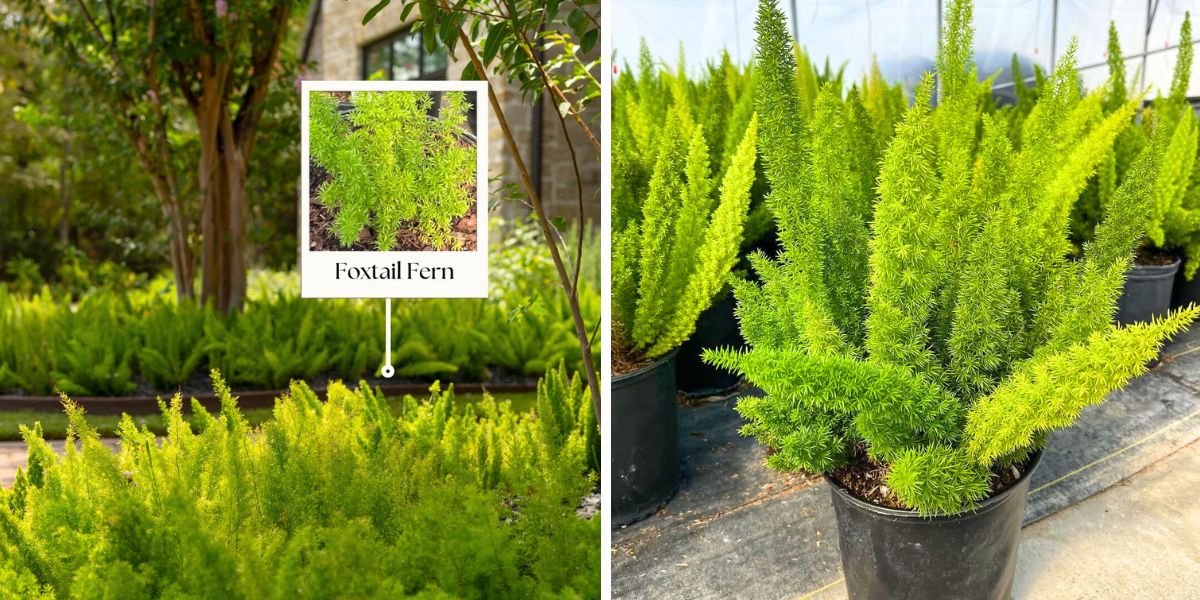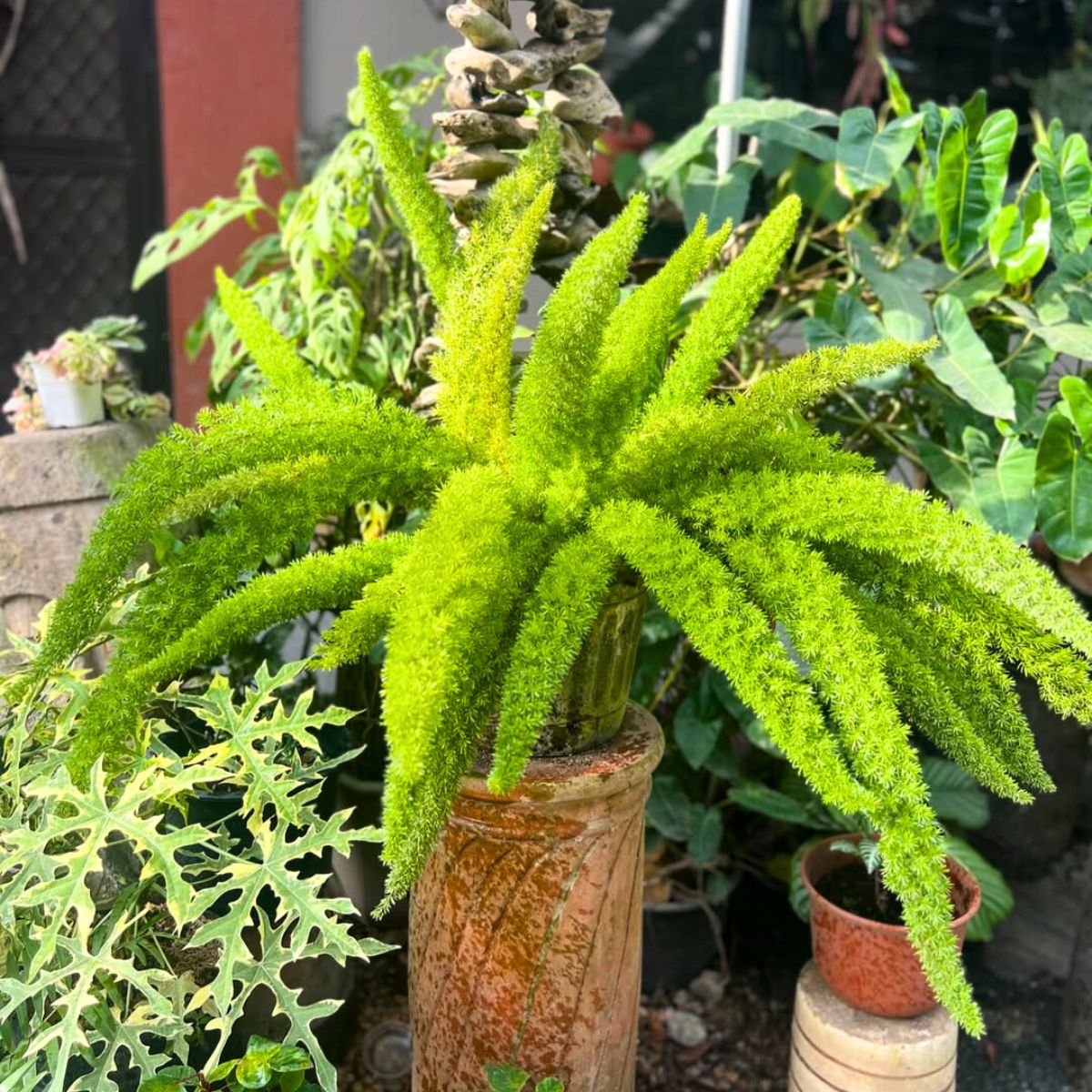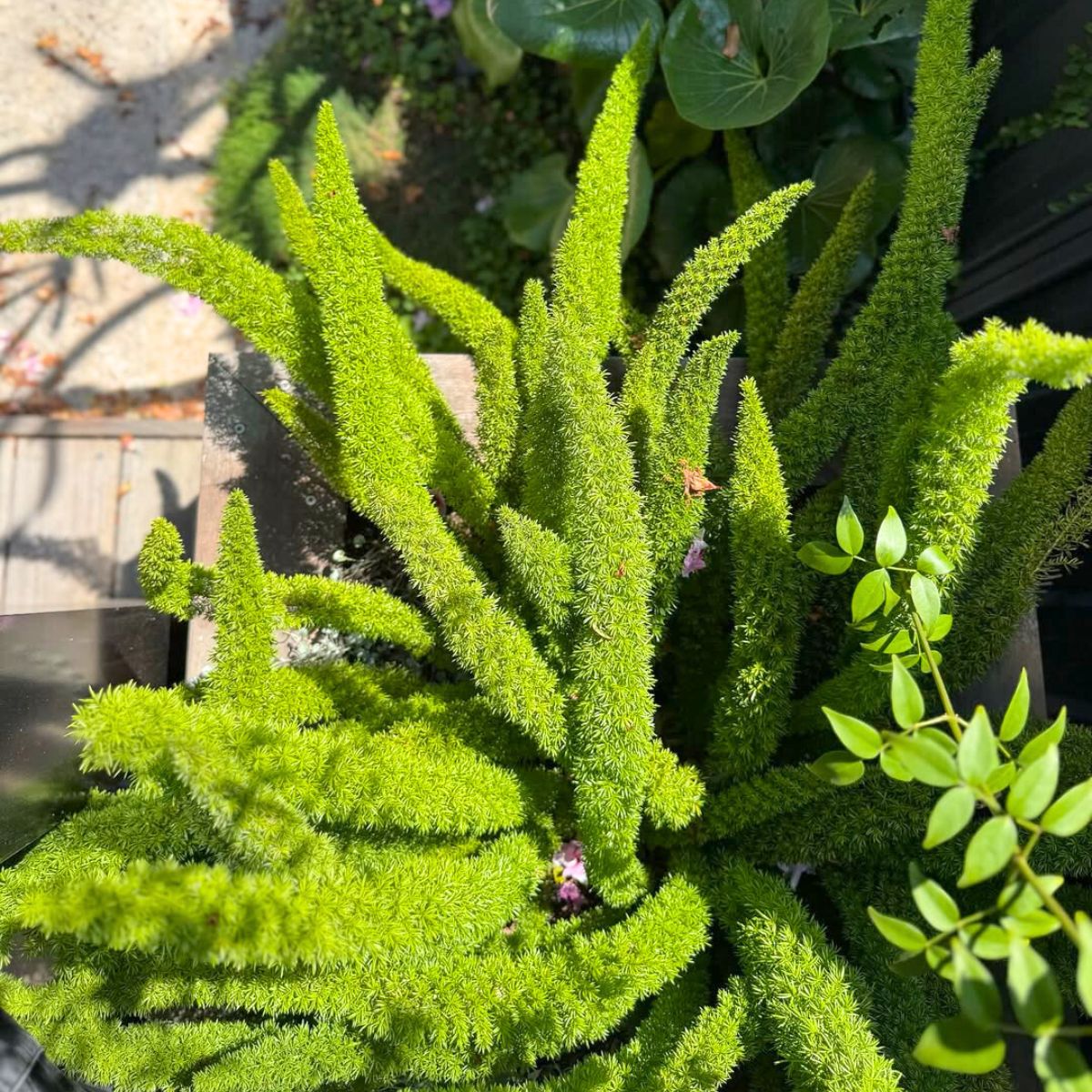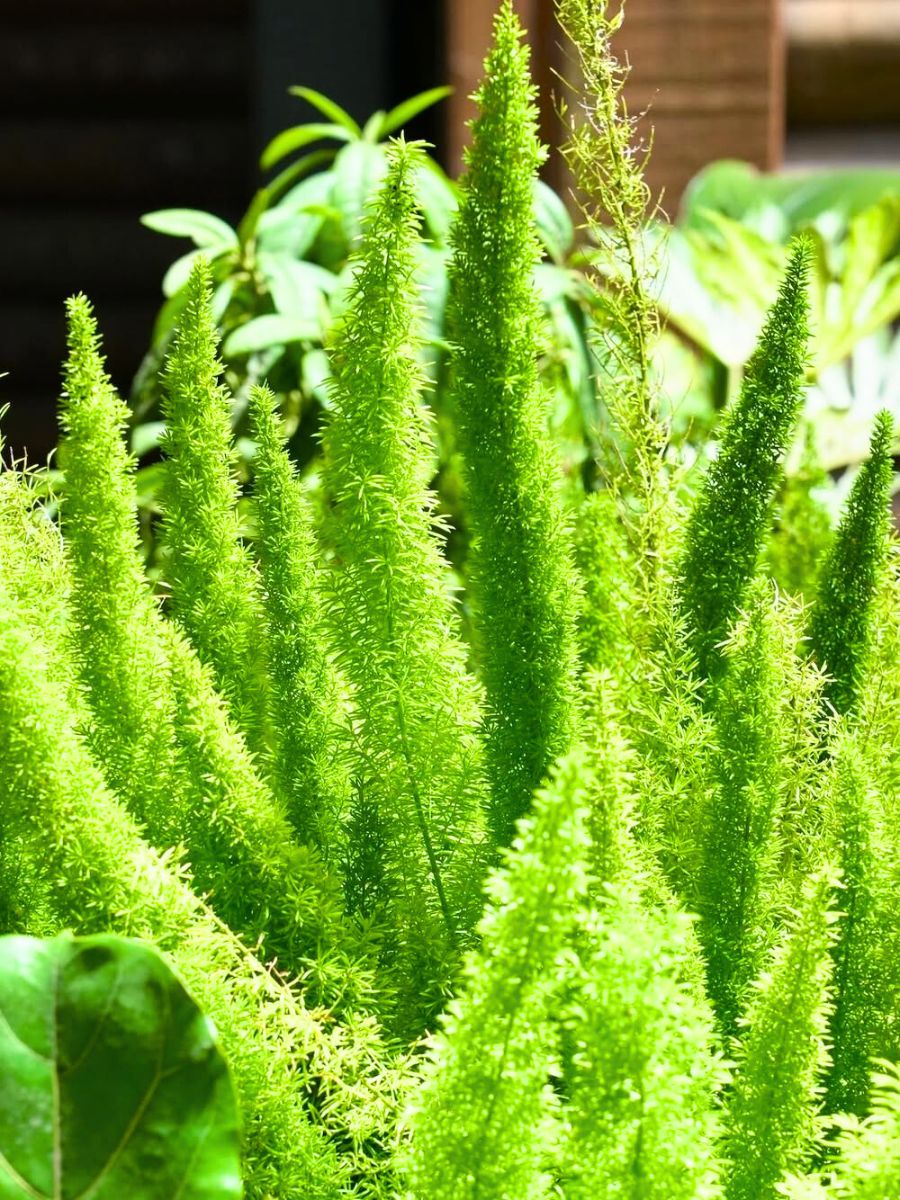The foxtail fern (Asparagus densiflorus) is a stunning evergreen plant known for its soft, needle-like foliage that forms dense, bushy, plume-like stems. With its unique appearance and hardy nature, it makes a perfect addition to both indoor spaces and outdoor gardens. Whether you're growing it in a pot or planting it in the ground, the foxtail fern is a low-maintenance beauty that thrives with the right care. In late spring to early summer, it even produces small white flowers, followed by bright red berries in the fall. If you’re looking to add some easy-to-care-for greenery to your space, here’s everything you need to know about growing and maintaining a healthy foxtail fern.
Meet the Foxtail Fern - Not a Fern, But Still Fabulous!
Though its name might trick you into thinking it's a true fern, the foxtail fern is actually part of the asparagus family, and it hails from the rocky, coastal regions of southeastern South Africa. This quirky plant has found its way around the world as a popular ornamental, gracing gardens and homes with its unique charm. While it may not have the typical fern fronds you might expect, it boasts upright, bushy, plume-like stems that resemble the tail of a fox—hence its name! Alongside ferns, here is a list of five other green foliage from Continental Floral Greens that you must have for your spring floral designs.

In late spring to early summer, it rewards you with small, fragrant white flowers, which eventually give way to vibrant red berries by fall. The variety commonly grown, ‘Myersii’, is especially compact and upright, growing to about 2 feet tall and spreading 3–4 feet wide. It’s a low-maintenance beauty that earned the Royal Horticultural Society's Award of Garden Merit in 1993. Talk about a showstopper!
Foxtail Fern Care
Foxtail ferns are hardy, low-maintenance plants known for their dense, upright fronds that resemble the tail of a fox. Despite their name, they’re not true ferns but members of the asparagus family. They grow well in both containers and garden beds, and adapt to a range of conditions, making them a practical choice for both indoor and outdoor spaces. With the right care, they’re reliable, long-lasting, and easy to manage.
When it comes to caring for the foxtail fern, know that it's quite hardy and has easy care requirements. All this plant needs is bright, indirect light and well-draining soil. Make sure you give the foxtail fern ample room to spread out, and trim the plant's spent flowers occasionally, too.

The foxtail fern is drought-tolerant because of its tuberous roots. Because of its strong root system, however, it can choke out smaller, more fragile plants in your garden, which is important to keep in mind. You can also care for the foxtail fern as a houseplant if you keep it in pots. In colder climates, you can easily bring the foxtail fern indoors. But don't worry, you're about to get the 101 on how to care for foxtail ferns in full detail.
Foxtail Ferns Light Requirement
Foxtail ferns thrive in environments that offer bright, gentle light. When grown outdoors, they prefer a spot with filtered or dappled sunlight, such as under a tree canopy or on a patio where the harshest rays of the day are softened. Morning sun is generally well-tolerated and can even support healthy growth, but by early afternoon, especially in warmer climates, foxtail ferns should be protected from direct, intense sunlight. Prolonged exposure to strong afternoon sun can lead to scorched leaves, browning tips, and stress on the plant.
If you're growing a foxtail fern indoors, choose a spot that gets bright, indirect light, such as near a window with a sheer curtain or in a room that receives plenty of natural daylight without direct sunbeams. East-facing windows are ideal, while south- or west-facing windows may need some light filtering to prevent leaf damage. Direct indoor sunlight, especially through glass, can intensify heat and light, which may cause the fronds to yellow or burn at the edges.
Maintaining the right light balance is essential for foxtail fern health—too little light can lead to weak, leggy growth, while too much can cause sun damage. Monitor the plant’s response and adjust placement if the leaves show signs of stress.

Foxtail Fern Soil Basics (No Fancy Stuff Required)
Foxtail ferns are not overly picky about soil, but they do require one crucial condition: good drainage. These plants are highly sensitive to excess moisture around their roots, so the soil must allow water to flow through easily. Waterlogged or compacted soil can quickly lead to root rot, a common issue that’s hard to reverse once it sets in.
The ideal soil for a foxtail fern is light, well-aerated, and fast-draining. A general-purpose potting mix works well, especially if you improve it with additions like perlite, coarse sand, or bark chips to boost drainage. If planting in the ground, make sure the soil doesn't stay soggy after rain. Raised beds or slightly sloped areas can help prevent water from pooling.

While foxtail ferns prefer slightly acidic soil (with a pH between 6.0 and 6.5), they are adaptable and can tolerate a broader range of soil pH levels. You don’t need to obsess over soil testing unless you’re growing in particularly alkaline conditions. In most cases, if your soil drains well and doesn’t stay heavy or wet for long periods, your foxtail fern will do just fine.
Whether you’re planting in a container or directly into your garden, making sure the roots aren’t sitting in soggy soil is the most important factor. Prioritize drainage over perfection, and your foxtail fern will thank you for it.
Foxtail Fern Watering Needs - Keep It Moist, Not Soaked
As mentioned before, the foxtail fern has tuberous roots, meaning they store water, even when the soil is dry. This is why the plant is drought-resistant, but also easy to overwater. For a happy plant, water once per week; allow the top three inches of its soil to dry out completely in between waterings.
In the event there's a drought, you may need to water more often; just make sure to test the soil with your finger beforehand. Finally, always allow for ample drainage when watering potted plants, and never let water sit in the tray. This can lead to waterlogging and root rot.
Temperature and Humidity Needs
The foxtail fern thrives in hot, humid weather because it is native to South Africa. If growing indoors, make sure to provide a source of moisture, such as a pebble tray with water, for humidity. Also, mist these plants regularly.
If you'd prefer to grow your foxtail fern outdoors, you can do so year-round in Zones 9a to 11b. Do note that if you live outside of these USDA zones, in colder climates, you'll have to take your foxtail fern indoors during the winter.
Fertilizer
In spring, begin to feed your foxtail and maintain monthly feedings during the growing season (summer) with a 10-10-10 plant food at half strength.Foxtail fern benefits from both slow-release and liquid fertilizers.
For garden ferns located outdoors, you can improve the soil each fall by adding one inch of compost around the plant and covering it with two inches of mulch.
Pruning Your Foxtail Fern
As with any garden perennial, foxtail fern requires the removal of stems at the base. This will help your plant look robust while encouraging new growth. Periodically, you can also pinch one inch off the stems to spur growth. Depending on the thickness of your foxtail's stem, this may require shears.
How to Propagate a Foxtail Fern
The simplest and most effective way to propagate a foxtail fern is by dividing the plant, ideally during spring when it’s actively growing. You’ll want to use a clean, sharp tool like a spade or knife to slice through the center of the root ball. Make sure each new section includes both roots and healthy foliage. Once replanted, give the divisions a thorough first watering to help them settle in.
Step-by-Step Foxtail Fern Propagation
-
Grab tools such as a sharp garden knife, spade or shears, plus soil conditioner, compost, and mulch.
-
Gently dig up the fern (or remove it from its pot, if it’s a potted plant) to expose the full root system.
-
Slice the root ball down the middle, making sure each half has a balanced portion of leaves and roots.
-
Prepare two planting holes that are wider than deep, and mix in some soil conditioner. Give each hole a quick watering and let it drain.
-
Place each divided root ball into its hole, ensuring the roots are fully covered. Backfill with a mix of garden soil and compost, then water generously.
-
After a day or two, apply compost or mulch around the base to help keep moisture in and protect the roots.

Photo: @goldleaflandscapes
Growing Foxtail Fern From Seed
While dividing an established plant is the faster way to propagate foxtail ferns, you can also grow them from seed. The seeds are found inside the plant’s small red berries, and although this method takes a bit more time and patience—usually two to three seasons for the plant to fully develop—it can be just as successful.
-
You’ll need small pots or seed trays, a glass of water, some plastic wrap, and a potting mix that includes vermiculite for drainage.
-
In autumn, collect the red berries from a mature foxtail fern. Soak them in water for 24 hours.
-
After soaking, keep only the seeds that sink to the bottom of the glass—these are more likely to sprout.
-
Fill your containers with potting mix and lightly mist the surface with water to moisten it.
-
Peel off the outer berry pulp, then press two seeds into each pot, about half an inch deep. Mist again lightly.
-
Cover each pot loosely with plastic wrap and place them somewhere warm with indirect light—a bright windowsill works well.
-
Keep the soil slightly moist (not soaked) by misting every few days. Germination usually takes around 3–4 weeks.
-
Once the seedlings are about 3–4 inches tall, choose the stronger of the two and remove the weaker one. As the plant grows, start acclimating it to the outdoors by placing it outside during the day and bringing it in at night until it’s ready to be planted in the garden.

Choosing the Right Pot (And Knowing When to Repot)
When growing a foxtail fern in a container, picking the right pot size really matters. If the pot is too big, it can trap excess moisture in the soil, which raises the risk of root rot. You’ll know it’s time to repot when the roots start pushing up through the surface or out of the drainage holes—this means the plant is root-bound and needs more space.
At that point, you have two options: move the plant into a pot that’s just slightly larger (about two inches wider), or split it into two and replant each half separately, similar to how you’d propagate it by division. Clay or unglazed stone pots work best because they allow the soil to breathe and wick away extra moisture, helping the plant stay closer to the conditions it naturally prefers.

Common Pests and Plant Diseases in Foxtail Ferns
Foxtail ferns are generally pest-resistant, but mealybugs and scale insects can occasionally cause issues. These pests suck sap from the plant, leading to weak, damaged foliage. To manage pests, apply organic neem oil to affected areas and repeat as needed.
Foxtail ferns can also suffer from powdery mildew and crown rot if overwatered in humid conditions. Prevent these fungal problems by ensuring your plant has well-draining soil and avoiding overwatering. If you spot mildew or rot, remove the affected parts and improve airflow around your fern. To manage the ecosystem around your plants, if you're planning to install a fabric greenhouse, here are five things that you should consider.

Photo: @homeofgreenplants
Get the Most Out of Your Foxtail Ferns
One of the most common issues with foxtail ferns is overwatering, which can lead to yellowing leaves or root rot. Let the top inch of soil dry out before watering again. If you use tap water, consider switching to filtered or distilled water to prevent chlorine damage.
Another common problem is insufficient light. Foxtail ferns need bright, indirect light, so if the leaves start to yellow, it may be a sign they’re not getting enough sunlight. Moving the plant to a brighter spot can often resolve this issue.

Take the time to care for your foxtail fern, and you’ll have a hardy, eye-catching plant that’ll stand strong and look great in any setting, season after season.
Foxtail ferns (Asparagus densiflorus) are typically varieties within the Asparagus genus, but they don’t have an extensive list of distinct types like some other plants. Most foxtail ferns are derived from the species Asparagus densiflorus, with some notable varieties and cultivars. Here's a list of popular types and varieties:
-
Asparagus densiflorus 'Myersii' (Commonly known as the Foxtail Fern)
-
Asparagus densiflorus 'Sprengeri' (Emerald Fern)
- Asparagus densiflorus 'Compacta' (A more compact form with denser foliage)
-
Asparagus densiflorus 'Meyers' (A smaller, more compact variant)
-
Asparagus densiflorus 'Dwarf' (A variety that remains smaller in size)
-
Asparagus densiflorus 'Variegatus' (Variegated variety with streaked green and cream leaves)
The foxtail fern is the sort of plant that rewards even modest attention with lush, architectural drama - indoors or out. Give it free-draining soil, bright but gentle light, and a sensible watering rhythm, and its emerald plumes will flourish year-round, punctuated by dainty blooms and jewel-like berries.
Whether you showcase a single 'Myersii' in a sculptural pot or mass several cultivars along a shaded border, this adaptable Asparagus densiflorus variety offers enduring texture, movement, and color. Nurture its simple needs, and the foxtail fern will return the favor with an effortless splash of evergreen elegance season after season.










